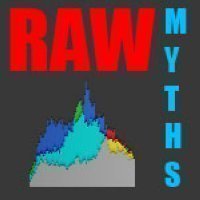RAW Myths & Facts
Introduction
 As the endless debate of RAW versus JPEG continues, more and more people appear to be confused as to why these two formats exist, what each is good for and when to use one or the other. First time DSLR users often wonder which format to choose and make a choice based on some random fact they heard. It does not help that a large number of incorrect information exists on the internet about the RAW and JPEG images. This feature dispels common myths encountered around the internet and in digital photography books.
As the endless debate of RAW versus JPEG continues, more and more people appear to be confused as to why these two formats exist, what each is good for and when to use one or the other. First time DSLR users often wonder which format to choose and make a choice based on some random fact they heard. It does not help that a large number of incorrect information exists on the internet about the RAW and JPEG images. This feature dispels common myths encountered around the internet and in digital photography books.
Get it right in the first place is the mantra of those who advocate JPEG and Shooting JPEG is like throwing away the negative is the motto of RAW advocates. As usual, both sides are right and it is therefore very important to understand the facts before choosing sides.
RAW Myths & Facts
Myth: RAW IS AN IMAGE FILE FORMAT
False. RAW files contain data which includes some information for each pixel but not enough to represent a digital image. Even in cases that actually store full color information for each pixel, such as in cameras which use a Foveon sensor, the stored information is not in the same color-space or scale as normal computer images.
Myth: RAW IS BETTER THAN JPEG
False. RAW has advantages over JPEG but so does JPEG over RAW. There would not be so much debates on the subject if it was not! The same JPEG as the camera would produce can be obtained from a RAW file using the camera manufacturer's RAW development software or in-camera RAW conversion on select models. This means that a RAW can at least produce an image of equal image quality.
Myth: IMAGES PRODUCED FROM RAW HAVE MORE DYNAMIC RANGE
False. Once a RAW file has been converted into an image, either explicitly by someone or implicitly by an image browser, it is limited by current display technology which cannot display more dynamic range or colors than a JPEG can hold. Nearly every display in existence uses 8 bits per channel (24 bits per pixel) which is what JPEG files store. All common operating systems are also incapable of displaying more than 8-bits per channel, even for the two monitors that can support more.
Myth: RAW FILES ARE DULL AND LOW CONTRAST
False. With all the hype about RAW quality, a huge number of people's first observation about RAW is that they look bad when compared to JPEG images. They only do by accident. As mentioned earlier, a RAW file contains data not an image. Therefore when a preview is for a RAW file is shown, software must produce an image from the RAW data. If it does that poorly, which is commonly the default for many image browsers, what is shown is a poor quality image. Usually the image looks dull and has low local contrast because it shows the entire tone curve uniformly.
Myth: RAW LOOKS EXACTLY LIKE JPEG
False. Several RAW files actually include an embedded JPEG. This embedded data allows fast previews and obviously looks exactly like a JPEG. Additionally, using the default conversion from camera maker's software normally does the exact same RAW to JPEG conversion as the camera. So there are cases where the RAW is converted into the exact same JPEG. However, the benefit of RAW lies in its ability to produce different results. Shooting RAW and then using the default conversion defeats its purpose. Benefits of shooting RAW are only seen when there is time to apply different processing.
Myth: JPEG IMAGES ARE SOFT AND LACK DETAILS
False. All DSLR cameras have settings that influence sharpness and noise reduction. Manufacturers seem to believe people prefer soft images over noisy images because the defaults are often high noise-reduction and middle sharpness. Those are only defaults and most digital cameras can produce images with finely tuned characteristics. Take the time to set up your camera to produce the most pleasing images possible.
Myth: JPEG FILES HAVE HORRIBLE ARTIFACTS
False. JPEG uses something called lossy compression which means some information is removed to make the file smaller. In practice the highest quality setting affects less than 2% of pixels by less than 0.4%. The data removed is also chosen to be the least perceptible to the human visual system.
Myth: EDITING JPEG DEGRADES IMAGE QUALITY
True. Anytime a JPEG is modified and then saved, compression may reduce image quality by a tiny amount. If done repeatedly it can add up to a substantial loss of image quality. The trick used by film artists to work with lossy formats is to do all the work in a lossless format and then save back the final version in a lossy format once all the work is done. Therefore it is better to do repetitive edits in PNG, TIFF or PSD and then save a final JPEG for printing or online use.
Myth: SHOOTING JPEG WITH A DSLR IS LIKE USING A POINT & SHOOT
False. DSLR cameras have a huge number of advantages over point & shoot digital cameras, including higher image quality and speed. Even DSLRs tend to shoot longer continuously in JPEG than in RAW.
Myth: REAL PHOTOGRAPHERS SHOOT RAW
False. The professional industry is just as divided on the subject as everyone else. They are pros that exclusively shoot JPEG, ones that exclusively shoot RAW, ones that always shoot JPEG+RAW and ones that use each format part of the time.
Myth: DNG IS A NON PROPRIETARY RAW FORMAT
 False. DNG belongs to Adobe. Adobe grants a license to use its patents to those who wish to use the DNG file format. While it is not owned by any camera manufacturer, it remains a file format that belongs to profit oriented corporation.
False. DNG belongs to Adobe. Adobe grants a license to use its patents to those who wish to use the DNG file format. While it is not owned by any camera manufacturer, it remains a file format that belongs to profit oriented corporation.
One of the reasons for DNG is to have a standard format that can be processed by future software long after the camera maker stops making a particular camera or goes out of business. While with is true in principal, the interpretation of the sensor data is specific to each camera and therefore that knowledge must be built in somewhere and kept up to date with new generations of software for legacy support. The one hope for longevity is to process RAW to a commonly understood DNG interpretation. Adobe covers part of what is needed for that in its 2009 DNG update which supports embedded profiles.
Myth: DNG CAN STORE RAW DATA FROM ANY DIGITAL CAMERA
True today. The DNG format was updated in 2009 to make sure it can hold the data produced by any current digital camera. It does contain special information to treat the information differently if it comes from a Fuji SuperCCD since the arrangement of pixels is different than conventional images. If other new technologies appear that does not fit the current DNG mold, Adobe has to change the DNG format to support those as well. Therefore more than one type of DNG files will exist and software will have to cope with the difference, just like they have to cope with different RAW formats.
Please Support Neocamera
All information on Neocamera is provided free of charge yet running this website is a huge endeavor. Purchases made via affiliate links found throughout the site help keep it running and up-to-date. There is no additional cost to you, so please consider buying via these links to our affilates:
If you found any information on this site valuable and did not purchase via our affiliate links, please considering donating via PayPal:
Any amount will be greatly appreaciated. Thank you for your support!
Updates
2024.04.03

Fujifilm X-T5 Review
Newest Fujifilm flagship boasting a 40 MP APS-C sensor, 5-axis IBIS with 7-stop efficiency, 15 FPS continuous drive, 6.2K Video capture, dual control-dials and dual SDXC UHS-II slots in a sturdy weatherproof and freezeproof body.
2023.11.20

Best Digital Cameras of 2023
Find out which are the Best Digital Cameras of 2023. All the new Mirrorless Digital Cameras from entry-level to high-end professional.
2023.07.10

Fujifilm X-H2 Review
40 Megapixels APS-C Hybrid Mirrorless Digital Camera with 7-stop IBIS. Fastest shutter ever and 8K video capture. Large builtin EVF with 0.8X magnification and 5.8 MP, plus an Eye-Start Sensor. Packed with features and large number of controls in a weatherproof and freezeproof body.
2023.05.07

Sony FE 20-70mm F/4G Review
Review of the unique Sony FE 20-70mm F/4G lens. The optical zoom of this lens spans ultra-wide-angle and medium focal-length coverage, making it one of the most versatile Full-Frame lenses on the market.
2023.01.15

Huion Inspiroy Dial 2 Review
Review of the Huion Inspiroy Dial 2 tablet, a medium sized drawing surface with dual dials and customizable buttons. Connects via USB-C or Bluetooth 5.0 with Windows, Linux and Android support.
2022.12.08

How to Pack for a Photo Trip
Find out how to pack for a travel photography trip, carry your gear safely while meeting airline regulations.
2022.11.13

Best Digital Cameras of 2022
The best digital cameras of 2022. A short list of the most outstanding models in their respective categories. Choose one for yourself or as a gift.
2022.09.21

Pentax DA* 60-250mm F/4 SDM Review
Review of the Pentax DA* 60-250mm F/4 SDM, the constant-aperture telephoto zoom with the highest zoom-ratio on the market.
2022.09.20

Pentax DA* 50-135mm F/2.8 SDM Review
Review of the Pentax DA* 50-135mm F/2.8 SDM, the lightest professional telephoto zoom native to the K-mount.
2022.09.10

Pentax DA* 11-18mm F/2.8 DC AW Review
Review of the Pentax DA* 11-18mm F/2.8 DC AW, the widest professional ultra-wide zoom native to the K-mount.
2021.11.24

50 Gifts Under $50 For Photographers in 2021
50 Gifts photographers will love. All for under $50 USD. 2021 Edition.
2021.11.17

Best Digital Cameras for 2021
Neocamera shows which are the very best Digital Cameras for 2021 in every category: Mirrorless, DSLR, Premium Compact, Ultra-Zoom and Rugged.
2024.04.03
2023.11.20
2023.07.10
2023.05.07
2023.01.15
2022.12.08
2022.11.13
2022.09.21
2022.09.20
2022.09.10
2021.11.24
2021.11.17
NEWS
2024.04.16

Sony Launches Bright Ultra-Wide Compact Zoom
Lens
2024.03.27

Sigma Ultra-Bright Normal Mirrorless Lens
Lens
2024.03.27

Nikon Launches Full-Frame Super-Zoom Lens
Lens
2024.03.20

New Lens Statistical Comparisons
2024.03.14

Fujifilm Brings New Features to Instax Series
Instant Camera
2024.03.07

Leica Launches SL3 Full-Frame Mirrorless
Digital Camera
2024.02.22

Panasonic Unveils Full-Frame Travel-Zoom Lens
Lens
2024.02.21

Sigma Reveals 2 Extreme Full-Frame Lenses
Lens
2024.02.21

Sony Reveals Bright Compact Full-Frame Zoom
Lens
2024.02.20

Venus Launches First Autofocus Lens
Lens
2024.02.20

Fujifilm Launches X100VI
Digital Camera
2024.01.16

Think Tank Launches Backlight Sprint Backpacks
Bag







